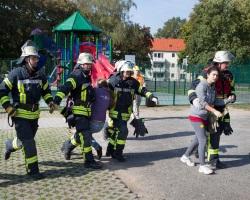Get downloadable PowerPoint presentation.
What Happened
On April 20, 1999, teens Eric Harris and Dylan Klebold walked into Colorado’s Columbine High School and started shooting. By the time they were done, 13 people were dead. It was one of the most shocking, tragic events in recent American history.
In the wake of that horrific day, and others disturbingly similar, most schools have improved their security to help students feel and be safe. However, critics wonder whether some are taking their security measures too far.
Many schools conduct regular drills to prepare students for attacks. Camey Elementary School in Texas recently spent $21.5 million for bulletproof glass in the front doors, 50 security cameras and a panic button, according to The Atlantic. Other schools are buying bulletproof whiteboards and bulletproof blankets—at a time when money in many districts is extremely tight.
“They think changing locks or adding a metal detector is all of a sudden going to make a school safe,” says Melissa Reeves, who has developed a teacher’s workshop to help educators better respond during a crisis. “Do you know what we could do with $10,000 to $25,000 in preventative programming?”
It’s important to remember the chance of a child dying in a school shooting is extraordinarily slim—one in 2.5 million. For comparison’s sake, the chance of being struck by lightning is 1 in 3,000, and some experts are worried that safety drills may inflict a sort of trauma of their own.
Last year, two apparent gunmen burst into a Florida middle school, waving weapons around. The gunmem actually were police officers and were shouting, “This is a drill!” as they ran through the halls, but many panicked children didn’t hear the disclaimer. Instead, many wept uncontrollably and texted their parents, telling them they thought they were about to die.
Most schools probably won’t replicate that failed drill anytime soon, but some states are mandating that districts take part in safety drills of some sort, which puts some principals in a difficult spot. How do you balance being better prepared versus the anxiety children might experience from getting prepared? “All you think about as a principal is what the students will be feeling,” one principal told The Atlantic.
Talk About It
Does your school conduct school shooting drills? If so, what do they look like? What do they ask you to do? Do you worry about shooters potentially invading your school? Do you think you’re more or less concerned about it than your friends?
Do you think drills such as this are a good idea, or do they scare more people than they help? Is finding a balance between preparedness and over-preparedness the answer? If they conduct such drills at your school, do you think it has the right balance?
What are you scared of happening? How do you deal with that fear? What helps you not to worry?
What the Bible Says
The Bible says it’s a good idea to plan for the future and any potential disaster that might come our way. The story of Joseph setting aside grain in Egypt to prepare for a famine is just one example.
“The plans of the diligent lead surely to abundance, but everyone who is hasty comes only to poverty” (Prov. 21:5).
God’s Word also tells us to not live in fear.
“For God gave us a spirit not of fear but of power and love and self-control” (2 Tim. 1:7).
“Fear not, for I am with you; be not dismayed, for I am your God; I will strengthen you, I will help you, I will uphold you with my righteous right hand” (Isa. 41:10).
“When I am afraid, I put my trust in you. In God, whose word I praise, in God I trust; I shall not be afraid. What can flesh do to me?” (Ps. 56:3-4).
Paul Asay has written for Time, The Washington Post and Christianity Today. He writes about culture for Plugged In and wrote the Batman book God on the Streets of Gotham (Tyndale). He recently collaborated with Jim Daly, president of Focus on the Family, on his book The Good Dad. He lives in Colorado Springs with wife, Wendy, and his two children. Check out his entertainment blog at Patheos.com/blogs/WatchingGod or follow him on Twitter @AsayPaul.




